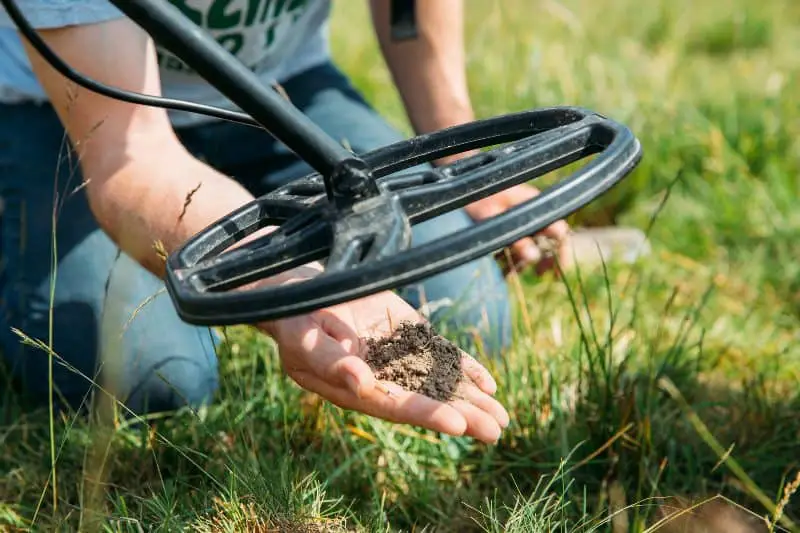
Calibrating your metal detector is definitely the most important skill you should learn if you want to have success unearthing and picking up valuable finds. But, how you can do so …
By understanding calibration general factors and the specific settings that come with your metal detector. Then by implementing the right settings depending on the target you are aiming for (its nature and size) as well as the ground conditions. And finally by doing the right setting adjustments whenever it’s needed.
In this article, you will learn the nitty gritty regarding the right approach when it comes to your detector’s calibration process, as well as some data points that you should definitely know about.
Why you need to calibrate your metal detector?
Metal detectors are sensitive equipment that needs to be calibrated from time to time. You may wonder why this periodic calibration is required …
Well, the goal of calibrating a metal detector is to find the very narrow sensitivity setting that allows you to locate metal targets without having the detector produce any type of excess or unwanted chatter.
Proper calibration is also needed to ensure that the detector is operating within the appropriate specification parameters and no outside influences can hinder the functioning of the equipment.
When you calibrate a metal detector, you are setting the detector to a certain sensitivity level.
Depending on what you intend to use the detector for, different sensitivities levels are set for each device to detect the desired type and size of metal.
At the same time, the different environments that a metal detector operates in also require calibration to different sensitivities so that it can discriminate properly between metals.
Its sensitivity setting determines the size of the metallic target that a detector reacts to. Most recreational or entry-level metal detectors also come with discrimination settings that will distinguish the types of metals the equipment will respond to.
As there are many manufacturers of metal detectors, each detector needs to be calibrated differently …
Indeed, when you purchase a new model, it is highly recommended to be aware of the different procedures involved in the calibration, validation, and audit of your machine.
There are some metal detectors in the market that are pre-calibrated to most environment types you are probably going to deal with (Trashy parks, clean fields, highly mineralized soil, salty beaches …)
Example: An example of such pre-calibrated machine is the Minelab Equinox 800. It comes with many pre-calibrated modes that you can set and start detecting right off the bat. You can learn about its features here.
In high-end metal detectors, you will find various other settings like discrimination and depth control …
These settings are pre-loaded into the detector so that with a simple push of a button, you can choose which type of metal you want the detector to react to.
Environmental factors are another common setting on most metal detectors that have to be kept in mind during calibration.
Many detectors have settings that will discriminate the target present in salty beaches, iron-heavy soil, and other environments.
These settings in a detector are designed to be accessible through the user interface of the machine and are simple to control and use.
Metal Detector Calibration procedure – Step-by-Step …
Here is a step-by-step guide to calibrating your metal detector.
To begin with, you are going to need the following:
- Small screwdriver
- 1-inch piece of iron
- A Metal detector
Step 1: Turn on the metal detector and let it warm up for 5 to 10 minutes. This ensures that the coil is working at full capacity before you begin the calibration process.
Step 2: Adjust the sensitivity to its maximum setting.
Step 3: Bring the discrimination to the minimum setting.
Step 4: Now pass the 1-inch piece of iron in front of the search coil. Keep it at a distance of 3/4 to 3 inches away from the coil.
If you get a very intermittent or spotty signal, it indicates that the machine may be too sensitive. On the other hand, hearing a very short beep or no signal means that the detector is not sensitive enough.
Now, remove the cover over the belt unit of the detector to calibrate the machine. The belt unit contains the batteries and electronic circuitry of the metal detector.
In some detectors, you might need to disconnect the pole and take off the cover. You will then need to reconnect the pole to the belt unit.
Step 5: Now locate the ground adjustment trimmer, which adjusts the signal amount the detector produces when a metal target passes in front of the search coil.
Step 6: You need to change the ground adjustment trimmer just a fraction of a turn.
Step 7: Keep changing the ground adjustment trimmer setting till the time you hear a single clear signal when you pass the piece of iron just 1 inch to 2 inches away from the search coil. Remember to move the piece of iron in a slow and methodical way, similar to how you would be detecting in real life.
Step 8: Put the cover back on the belt unit. If you had to disconnect the pole to take off the cover, you could reconnect the pole back now.
Step 9: Reassemble your machine.
Congratulations! You have successfully calibrated your metal detector.
How frequently should you review your detector calibration?
Most metal detectors need to be calibrated periodically. Most manufacturers recommend calibrating your machine at least once a year to ensure that it keeps functioning at the best of its capabilities.
If you find that your detector is giving erratic readings, you can also calibrate it more than once annually. Preferably once a quarter!
You can also calibrate your metal detector if you are changing the terrain on which you usually detect…
For example, suppose from a hilly area you suddenly shift to detecting at the beach. In that case, it will help your metal detector operate properly if you calibrate it once as per the new environment.
Calibration limitations …
Calibration could have some limitations, especially for some metal detectors that have limited setting options or with a setting that it is not high or low enough.
In other words, even if you calibrate some machines, it won’t be enough to find gold nuggets in highly mineralized soil for example.
Simply, because you need machines with very high frequencies to be able to do so. And if you’ve got a VLF detector that operate on a low frequency (usually less than 10 kHz), then you shouldn’t expect finding raw gold (especially smaller ones) and especially on highly conductive soil.
Again, for the conductive soil, if your machine lacks the ground balancing feature, then your machine will struggle even if you’ve got it well calibrated. Indeed, it will pick up false (annoying) signals pretty much all the time.
Also, let’s say you want to detect at really high depth, but you have a machine with only a smaller search coil. Then also in this case, calibration won’t be enough to be able to detect deep enough. You will need a larger coil to scan more space and in a bigger depth.
Should you worry about calibrating a cheap metal detector?
Let’s say you have a very cheap metal detector like the bounty hunter tracker 4 (Check it Here at Amazon). Even if you it is not a high end model, you still should go through the calibrating procedure explained above …
Of course, such a machine don’t offer a ton of options when it comes to the possible settings, but it still gives you the possibility to set the sensitivity and discrimination levels which are well enough for this process.
So, don’t be like “I won’t bother the headaches of calibrating this cheap machine!”. Instead, follow the process once a quarter and you will find out that even such an entry level metal detector will keep giving you positive results over the years.
Should you calibrate a pinpointer metal detector?
A pinpointer is an accessory that you definitely need amongst your gear. However, there is no need to calibrate it whatsoever.
Simply, because you have to point the tip of the pinpointer directly into the sand, soil, or saltwater to calibrate them with the help of a button.
This button is usually named Calibrate, Retune, or something similar. So it just does this spontaneously!
Final Thoughts …
Hope this article was helpful and gave you an idea on how to deal with this important skill that you should have as a detectorist.
Don’t worry if you follow the process and fail. This doesn’t mean that the process is wrong. You just might need a bit more time to fully understand how the calibrating process that will work for your machine.
Indeed, each detector is different, each brand/manufacturer is different, modern machines are not the same as the older ones released 5 or 10+ years ago.
Learning the process for your own machine might take some time. Be consistent and you will figure it hands down!
